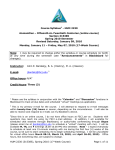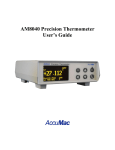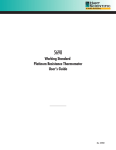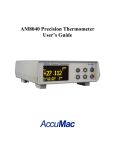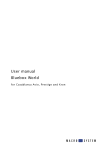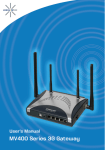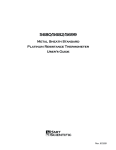Download Glass Capsule Standard Platinum Resistance
Transcript
5686 Glass Capsule Standard Platinum Resistance Thermometer Users Guide 2004, Rev. 1, 4/11 © 2004 - 2011 Fluke Corporation. All rights reserved. Specifications subject to change without notice. All product names are trademarks of their respective companies. Limited Warranty & Limitation of Liability Each Fluke product is warranted to be free from defects in material and workmanship under normal use and service. The warranty period is one year and begins on the date of shipment. Parts, product repairs, and services are warranted for 90 days. This warranty extends only to the original buyer or end-user customer of a Fluke authorized reseller, and does not apply to fuses, disposable batteries, or to any product which, in Fluke’s opinion, has been misused, altered, neglected, contaminated, or damaged by accident or abnormal conditions of operation or handling. Fluke warrants that software will operate substantially in accordance with its functional specifications for 90 days and that it has been properly recorded on non-defective media. Fluke does not warrant that software will be error free or operate without interruption. Fluke authorized resellers shall extend this warranty on new and unused products to end-user customers only but have no authority to extend a greater or different warranty on behalf of Fluke. Warranty support is available only if product is purchased through a Fluke authorized sales outlet or Buyer has paid the applicable international price. Fluke reserves the right to invoice Buyer for importation costs of repair/replacement parts when product purchased in one country is submitted for repair in another country. Fluke’s warranty obligation is limited, at Fluke’s option, to refund of the purchase price, free of charge repair, or replacement of a defective product which is returned to a Fluke authorized service center within the warranty period. To obtain warranty service, contact your nearest Fluke authorized service center to obtain return authorization information, then send the product to that service center, with a description of the difficulty, postage and insurance prepaid (FOB Destination). Fluke assumes no risk for damage in transit. Following warranty repair, the product will be returned to Buyer, transportation prepaid (FOB Destination). If Fluke determines that failure was caused by neglect, misuse, contamination, alteration, accident, or abnormal condition of operation or handling, including overvoltage failures caused by use outside the product’s specified rating, or normal wear and tear of mechanical components, Fluke will provide an estimate of repair costs and obtain authorization before commencing the work. Following repair, the product will be returned to the Buyer transportation prepaid and the Buyer will be billed for the repair and return transportation charges (FOB Shipping Point). THIS WARRANTY IS BUYER’S SOLE AND EXCLUSIVE REMEDY AND IS IN LIEU OF ALL OTHER WARRANTIES, EXPRESS OR IMPLIED, INCLUDING BUT NOT LIMITED TO ANY IMPLIED WARRANTY OF MERCHANTABILITY OR FITNESS FOR A PARTICULAR PURPOSE. FLUKE SHALL NOT BE LIABLE FOR ANY SPECIAL, INDIRECT, INCIDENTAL, OR CONSEQUENTIAL DAMAGES OR LOSSES, INCLUDING LOSS OF DATA, ARISING FROM ANY CAUSE OR THEORY. Since some countries or states do not allow limitation of the term of an implied warranty, or exclusion or limitation of incidental or consequential damages, the limitations and exclusions of this warranty may not apply to every buyer. If any provision of this Warranty is held invalid or unenforceable by a court or other decision-maker of competent jurisdiction, such holding will not affect the validity or enforceability of any other provision. Fluke Corporation Fluke Europe B.V. P.O. Box 9090 P.O. Box 1186 Everett, WA 98206-9090 5602 BD Eindhoven U.S.A.The Netherlands 11/99 Table of Contents Title Page Introduction..........................................................................................................................1 Before You Start...................................................................................................................1 Symbols Used..................................................................................................................1 Safety Information...........................................................................................................2 Application.......................................................................................................................3 Calibration.......................................................................................................................3 Recalibration....................................................................................................................3 Return Procedure.............................................................................................................3 Verifying Probe Accuracy................................................................................................3 How to Contact Fluke......................................................................................................4 Specifications.......................................................................................................................5 Construction.....................................................................................................................5 Installation...........................................................................................................................5 Environmental Issues.......................................................................................................5 Mounting..........................................................................................................................5 Electrical Circuit..............................................................................................................5 Care and Handling Guidelines.............................................................................................6 SPRT Care........................................................................................................................6 Handling Guidelines........................................................................................................6 Operation.............................................................................................................................6 General.............................................................................................................................6 Comparison Calibration of Other Instruments.................................................................6 Measuring Current...........................................................................................................7 Thermal EMF.......................................................................................................................7 i 5686 Users Guide ii List of Tables Table Page Title Table 1. International Electrical Symbols................................................................................................2 Table 2. Specifications.............................................................................................................................5 iii 5686 Users Guide iv List of Figures Figure Title Page Figure 1. 5686 Glass Capsule Standard Platinum Resistance Thermometer...........................................1 Figure 2. The construction of 5686 SPRT................................................................................................5 v 5686 Users Guide vi Introduction The Fluke Calibration Glass Capsule Standard Platinum Resistance Thermometer (SPRT) is designed to be the best primary standard interpolating instrument converting temperature to resistance. The Fluke 5686 Glass Capsule SPRT is a member of the Fluke Calibration SPRT family (Figure 1). The 5686 SPRT is primarily designed for the following two applications: used in low temperature range down to 13 K (–260 °C), or used where a totally immersed probe is prefered to minimize the heat flow from or to the sensor. Long stem SPRTs are not suitable for some applications where the probe should be encased into a vessel completely. The 5686 SPRT covers the range from 13 K (–260 °C) to 505 K (232 °C). The 5686 is carefully annealed at the appropriate temperatures and precisely tested for stability. The sensing elements are fabricated using high-purity platinum wire wound in a strain-free design on a fused silica cross frame. The special glass capsule of the 5686 is pressure sealed with 5N pure helium. 5686.tif Figure 1. 5686 Glass Capsule Standard Platinum Resistance Thermometer Before You Start Symbols Used Table 1 lists the International Electrical Symbols. Some or all of these symbols may be used on the instrument or in this manual. 1 5686 Users Guide Table 1. International Electrical Symbols Symbol Description Symbol Description O Off I On X Electric Shock : Hot Surface (Burn Hazard) W Read the User’s Manual (Important Information) I B D AC (Alternating Current) M F DC ) Canadian Standards Association T Double Insulated P CE Complies with European Union Directives . AC-DC PE Ground ; Fuse Battery C-TIC Australian EMC Mark CAT II equipment is designed to protect against transients from energyequipment supplied from CAT II consuming the fixed installation, such as TVs, PCs, portible tools, and other household appliances. Safety Information Use this instrument only as specified in this manual. Otherwise, the protection provided by the instrument may be impaired. The following definitions apply to the terms “Warning” and “Caution”. • “Warning” identifies conditions and actions that may pose hazards to the user. • “Caution” identifies conditions and actions that may damage the instrument being used. Warning To avoid personal injury, follow these guidelines. • DO NOT use this instrument to measure the temperature of any hazardous live component. • DO NOT use this instrument for any application other than calibration work. • DO NOT use this instrument in environments other than those listed in the user’s guide. • Use of this instrument at high temperatures for extended periods of time can cause the handle to become hot. • Follow all safety guidelines listed in the Users Guide. • Calibration equipment should only be used by trained personnel. 2 Glass Capsule Standard Platinum Resistance Thermometer Before You Start Caution To avoid possible damage to the instrument, follow these guidelines. • DO NOT remove the label from the handle. The delicate nature of the instrument is described on the label. • Read “Care and Handling Guidelines” before removing the SPRT from the shipping box or case. Incorrect handling can damage the SPRT and void the warranty. • DO NOT subject the thermometer to any physical shock or vibration. • Keep the shipping container in case it is necessary to ship the SPRT. Incorrect packaging of the SPRT for shipment can cause irreparable damage. • DO NOT subject the thermometer to temperatures above the highest specified operating temperature. • DO NOT expose the thermometer’s handle or cables to extreme temperatures. • DO NOT submerge the handle or cable in liquids. Application The 5686 thermometer is classified as a primary standard. A primary standard is defined in terms of transfer of the ITS-90 from a standards laboratory to a customer’s laboratory. Primary standards are calibrated in a standards lab using known intrinsic values. The SPRTs are designed to meet the National Voluntary Laboratory Accreditation’s (NVLAP) Level I Accuracy Class. Calibration In order for any instrument to be used as a standard it must be calibrated. The SPRT may be purchased calibrated or non-calibrated. Fluke Calibration has the capability of performing fixed point calibration, or comparison calibrations traceable to NIST. Recalibration The recalibration of the SPRT should be scheduled according to the user’s company Quality Assurance requirements. Normally, an SPRT is recalibrated annually. Fluke Calibration has the capability of performing fixed point calibration, or comparison calibrations traceable to NIST. Return Procedure Not Call the nearest Authorized Service Center for assistance before shipping. Extreme care must be taken in shipping an SPRT. Place the thermometer in the factory provided protective storage case. Be sure the case is latched securely. Place the protective case in the original manufacturer’s wooden shipping crate or wooden crate with similar dimensions. Place soft insulation on all sides of the crate to cushion the SPRT against mechanical shocks. The cover of the crate should be attached with screws. We recommend that you label the crate as extremely fragile. Whether the thermometer is returned for repair or warranty, please include a letter containing the following information: • Description of the faulty operation and circumstances of failure. • Complete shipping instructions for the return of the thermometer to the customer. 3 5686 Users Guide Verifying Probe Accuracy Before using your probe, verify that its behavior has not changed significantly from the most recent calibration (as can sometimes occur from mechanical shock during shipping, for example). To verify your probe, check the probe at the Triple Point of Water (TPW) (0.01 °C) or in a wellconstructed ice bath, by following these steps: 1.Connect the probe to a calibrated readout and verify that the probe’s coefficients have been correctly entered into the readout. 2.Properly prepare a TPW cell or ice bath. Contact Fluke Calibration for assistance. A TPW cell is preferred. Ice baths should use distilled water and crushed ice in a Dewar flask or thermos bottle. The ratio of ice-to-water should be such that the mixture is firm after prepared. 3.Set your readout to read in ohms rather than temperature. Place your probe in the TPW or ice bath and allow it to stabilize. (Remember a TPW is at 0.01 °C and an ice bath is at 0 °C.) 4.If using a TPW cell, compare the resistance value on your readout with the resistance value at TPW given on the probe’s certificate. If using an ice bath, compare the resistance value on your readout with the resistance indicated on the certificate for 0 °C. (You may have to use the probe’s temperature versus resistance table and interpolate to get the probe’s calibrated resistance value at 0 °C.) 5.Considering the probe’s uncertainty specification, determine whether or not it is within tolerance of the data on its most recent certificate of calibration. If it is, it may be placed in service. If not, double-check the probe coefficients in the readout. If they are correct, contact Fluke Calibration. Fluke Calibration recommends that a probe be periodically checked against a standard such as a TPW cell (or well-constructed ice bath if an ITS-90 fixed-point standard is not available). The verification interval depends on how the probe is handled, how and how much it is used, and your documented experience with it. Your probe should also be checked any time you suspect it may have received mechanical shock or whenever its accuracy appears suspect. How to Contact Fluke To contact Fluke, call one of the following telephone numbers: • Technical Support USA: 1-800-44-FLUKE (1-800-443-5853) • Calibration/Repair USA: 1-888-99-FLUKE (1-888-993-5853) • Canada: 1-800-36-FLUKE (1-800-363-5853) • Europe: +31 402-675-200 • Japan: +81-3-3434-0181 • Singapore: +65-738-5655 • Anywhere in the world: +1-425-446-5500 Or, visit Fluke’s website at www.fluke.com. To register your product, visit http://register.fluke.com. To see, print, or download the latest manual supplement, visit http://us.fluke.com/usen/support/manuals. 4 Glass Capsule Standard Platinum Resistance Thermometer Specifications Specifications Table 2. Specifications 5686 Specifications Temperature range –260 °C to 232 °C Nominal Rtp 25.5 Ω Resistance ratio W(302.9146 K) ≥1.11807, W(234.3156 K) ≤0.844235 Drift rate over the entire range <0.005 °C per year Drift rate over a range of 100 °C Typically 0.001 °C per year Filling gas Pure helium (99.999 %) Lead wires Four platinum wires, 3 cm long Diameter (mm) 5.5 ±0.3 Length (mm) 56 Construction Construction of the 5686 SPRT is shown in Figure 2. The 5686 covers the range from 13 K to 505 K. The 25.5 Ω sensor element is crafted using high purity platinum wire wound in a strain free design on a fused silica cross frame. Glass Sheath Sensor Support Glass-Platinum Seal Platinum Helix Platinum Lead Wires 5686.eps Figure 2. The construction of 5686 SPRT Installation Environmental Issues Primary standard equipment should be used in a calibration laboratory or other facility specifically designed for this purpose. Environmental requirements include: • • • • Stable temperature and humidity Clean, draft-free area Low noise level: low radio frequency, magnetic or electrical interference Low vibration levels Mounting Capsule-type SPRTs are usually used “totally immersed”, meaning that they are generally inserted into a well in a copper block. The connections are made to long fine copper wires insulated with varnish or a similar coating, and these are thermally anchored to the block and to at least one other point within the cryostat so as to reduce or eliminate heat flow into or from the thermometer. For applications above 100 °C, the user should decide how to mount the capsule in his apparatus according to the conditions. Electrical Circuit The 5686 SPRT is equipped with four platinum wires with Teflon sleeves. Four lead wires are used to cancel lead wire resistance. For best results, the readout device should be equipped to handle four-terminal resistors. The lead wire colors are red and black. Two red color leads are from one end of the sensor resistance, and two black leads are from another end (See Figure 2). 5 5686 Users Guide Care and Handling Guidelines Caution Read before removing the SPRT from the case. SPRT Care The 5686 capsule Standard Platinum Resistance Thermometer (SPRT) is an extremely delicate instrument. Great care must be taken in handling the SPRT to maintain calibration accuracy. Vibration or shock may cause the resistance to increase. A slight tap to the SPRT tip can cause a change in Rtpw as high as 1 mK. The glass capsule should always be wiped down with 200 proof Ethyl Alcohol or other suitable solvent before exposure to high temperatures. Correct handling of the SPRT will prolong the life expectancy. When not in use, the SPRT should be stored in the protective case provided by Fluke. Handling Guidelines • Keep the thermometer as clean as possible. Always remove any fluid from the sheath immediately after taking the thermometer from a bath. To remove any possible contaminants, always wipe the sheath with Ethyl Alcohol or other solvent before submitting the SPRT to high temperatures. • Immerse the thermometer in the appropriate liquid for the temperature range. If a dry block is used, the well diameter should allow the SPRT to comfortably slip in and out without excess movement. For best results, immerse the thermometer as deep as possible to avoid “stem effect” (the temperature error caused by the conduction of heat away from the sensor). Do not submerge the handles. • Allow sufficient time for the thermometer to stabilize before making measurements. This allows for the best accuracy. • Use the correct drive current with the thermometer to prevent error in temperature or resistance. • Anneal the thermometer at a temperature slightly higher than the maximum temperature at which the thermometer will be used when it has been subjected to mechanical or temperature shock. The SPRT should also be annealed before calibration. If the thermometer is annealed in a furnace above 660 °C, the furnace should be base metal free. • Use the protective case provided or other protection when the thermometer is not in use. • DO NOT subject the thermometer to any physical shock or vibration. • DO NOT subject the thermometer to temperatures above the highest specified operating temperature. • DO NOT expose the thermometer’s cables to extreme temperatures. Operation General For best results, be familiar with the operation of the cryostat, calibration bath or furnace and the read-out instrument. Be sure to follow the manufacturer’s instructions for the read-out instrument, cryostat, and the calibration bath or furnace. 6 Glass Capsule Standard Platinum Resistance Thermometer Operation Comparison Calibration of Other Instruments The uniformity and stability of the bath and the degree of accuracy required determine the number of temperature measurements necessary. However, to follow “good” practice procedures, always measure the triple point of water resistance (Rtpw) after each temperature measurement. This provides the most accurate measurement of the resistance ratio: W(t) = R(t) Rtpw Measuring Current The recommended current for the 5686 is 1 mA for most situations. The resistance sensitivity with temperature becomes lower at lower temperatures. To compensate for the loss of sensitivity, measuring currents below 24.5 K are generally increased from 1 mA usually used above that temperature, up to about 5 mA at 13.8 K. Errors caused by self-heating of the element need to be minimized. Allowing sufficient time for the SPRT to stabilize and the heat to be dispersed into the surrounding medium will provide the most accurate results. The Fluke testing or calibration certificates provided with the SPRT represent data that has been extrapolated. For example, on Model 5686 measurements are made at 1 mA and 1.41 mA. These measurements are then extrapolated to zero current. This can be done graphically by plotting i² vs R and extrapolating to zero power or by using the following equation: R0=R1 - i12 (R2 - R1) i22 - i12 Where: R0 = Zero current resistance R1 = Resistance measured at current i1 R2 = Resistance measured at current i2 The exact immersion depth required can be determined by performing a gradient test taking measurements approximately every 1/2 inch (1.27 cm) until there is a significant difference in readings. Allow the thermometer to stabilize at each new depth. Plot the results to see the stem effect. Thermal EMF Two factors contribute to thermal EMF, chemical consistency and physical consistency. Variations in chemical structure due to impurities and discrepancies in crystal structure can contribute to thermal EMF. These factors are minimized by annealing the full length of wire before construction of the SPRT. Likewise, connection to extension lead wires and readout instruments can be a source of thermal EMF. The thermal EMF is caused by a difference in temperature between two connections. If the two connections are the same temperature, there will be little or no thermal EMF effects. However, if there is a substantial temperature difference between connections, the thermal EMF effects will be significant. Therefore, cover or insulate any exposed bridge or galvanometer terminals to lessen the source of error. The effects of thermal EMF can be canceled by using an ac bridge or a dc bridge with reversible current. 7 5686 Users Guide 8

















